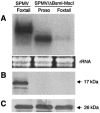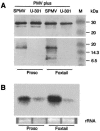The capsid protein of satellite Panicum mosaic virus contributes to systemic invasion and interacts with its helper virus
- PMID: 16014937
- PMCID: PMC1181559
- DOI: 10.1128/JVI.79.15.9756-9764.2005
The capsid protein of satellite Panicum mosaic virus contributes to systemic invasion and interacts with its helper virus
Abstract
Satellite panicum mosaic virus (SPMV) depends on its helper Panicum mosaic virus (PMV) for replication and spread in host plants. The SPMV RNA encodes a 17-kDa capsid protein (CP) that is essential for formation of its 16-nm virions. The results of this study indicate that in addition to the expression of the full-length SPMV CP from the 5'-proximal AUG start codon, SPMV RNA also expresses a 9.4-kDa C-terminal protein from the third in-frame start codon. Differences in solubility between the full-length protein and its C-terminal product were observed. Subcellular fractionation of infected plant tissues showed that SPMV CP accumulates in the cytosol, cell wall-, and membrane-enriched fractions. However, the 9.4-kDa protein exclusively cofractionated with cell wall- and membrane-enriched fractions. Earlier studies revealed that the 5'-untranslated region (5'-UTR) from nucleotides 63 to 104 was associated with systemic infection in a host-specific manner in millet plants. This study shows that nucleotide deletions and insertions in the 5'-UTR plus simultaneous truncation of the N-terminal part of the CP impaired SPMV spread in foxtail millet, but not in proso millet plants. In contrast, the expression of the full-length version of SPMV CP efficiently compensated the negative effect of the 5'-UTR deletions in foxtail millet. Finally, immunoprecipitation assays revealed the presence of a specific interaction between the capsid proteins of SPMV and its helper virus (PMV). Our findings show that the SPMV CP has several biological functions, including facilitating efficient satellite virus infection and movement in millet plants.
Figures







Similar articles
-
The complex subcellular distribution of satellite panicum mosaic virus capsid protein reflects its multifunctional role during infection.Virology. 2008 Jun 20;376(1):154-64. doi: 10.1016/j.virol.2008.03.013. Epub 2008 Apr 28. Virology. 2008. PMID: 18440039
-
Genetic identification of multiple biological roles associated with the capsid protein of satellite panicum mosaic virus.Mol Plant Microbe Interact. 2001 Jan;14(1):21-30. doi: 10.1094/MPMI.2001.14.1.21. Mol Plant Microbe Interact. 2001. PMID: 11194868
-
In vitro- and in vivo-generated defective RNAs of satellite panicum mosaic virus define cis-acting RNA elements required for replication and movement.J Virol. 2000 Mar;74(5):2247-54. doi: 10.1128/jvi.74.5.2247-2254.2000. J Virol. 2000. PMID: 10666255 Free PMC article.
-
Biology and structure of plant satellite viruses activated by icosahedral helper viruses.Curr Top Microbiol Immunol. 1999;239:123-43. doi: 10.1007/978-3-662-09796-0_7. Curr Top Microbiol Immunol. 1999. PMID: 9893372 Review. No abstract available.
-
[Subviral molecules of RNA associated with plant ss(+)RNA viruses].Postepy Biochem. 2006;52(2):212-21. Postepy Biochem. 2006. PMID: 17078511 Review. Polish.
Cited by
-
Molecular interactions of plant viral satellites.Virus Genes. 2021 Feb;57(1):1-22. doi: 10.1007/s11262-020-01806-9. Epub 2020 Nov 23. Virus Genes. 2021. PMID: 33226576 Review.
-
Effect of cultivar and temperature on the synergistic interaction between panicum mosaic virus and satellite panicum mosaic virus in switchgrass.Arch Virol. 2022 May;167(5):1247-1256. doi: 10.1007/s00705-022-05412-y. Epub 2022 Mar 28. Arch Virol. 2022. PMID: 35344095
-
Involvement of the plant nucleolus in virus and viroid infections: parallels with animal pathosystems.Adv Virus Res. 2010;77:119-58. doi: 10.1016/B978-0-12-385034-8.00005-3. Adv Virus Res. 2010. PMID: 20951872 Free PMC article. Review.
-
Satellite RNAs and Satellite Viruses of Plants.Viruses. 2009 Dec;1(3):1325-50. doi: 10.3390/v1031325. Epub 2009 Dec 18. Viruses. 2009. PMID: 21994595 Free PMC article.
-
Self-assembly of model proteins into virus capsids.J Phys Condens Matter. 2017 Nov 29;29(47):474003. doi: 10.1088/1361-648X/aa9351. J Phys Condens Matter. 2017. PMID: 29027904 Free PMC article.
References
-
- Batten, J. S. 2002. Replication and translation of panicum mosaic virus. Ph.D. dissertation. Texas A&M University, College Station.
-
- Buzen, F. G., C. L. Niblett, G. R. Hooper, J. Hubbard, and M. A. Newman. 1984. Further characterization of panicum mosaic virus and its associated satellite virus. Phytopathology 74:313-318.
-
- Callaway, A., D. Giesman-Cookmeyer, E. T. Gillock, T. L. Sit, and S. A. Lommel. 2001. The multifunctional capsid proteins of plant RNA viruses. Annu. Rev. Phytopathol. 39:419-460. - PubMed
-
- Chapman, S., T. Kavanagh, and D. Baulcombe. 1992. Potato virus X as a vector for gene expression in plants. Plant J. 2:549-557. - PubMed
Publication types
MeSH terms
Substances
LinkOut - more resources
Full Text Sources
Miscellaneous

